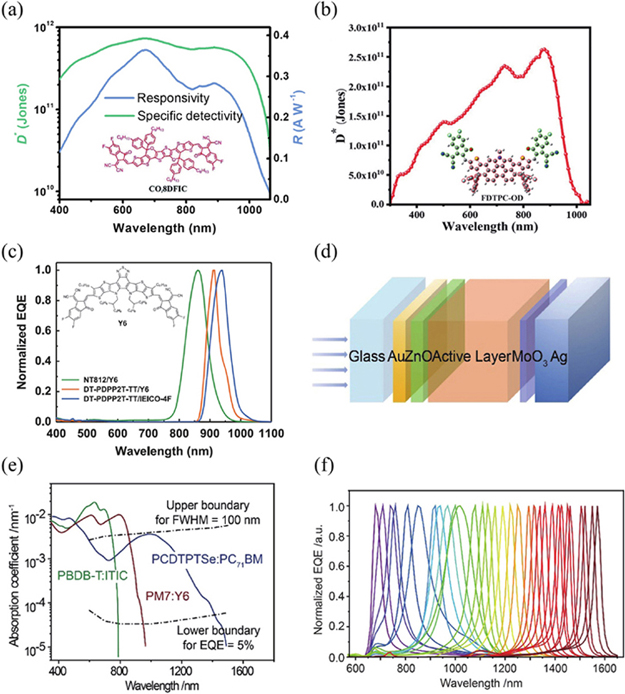In terms of bandwidth modulation, another topic is filterless narrowband photodetection[16,17], which is crucial for color discrimination. An approach called charge collection narrowing (CCN) was reported to effectively narrow photoresponse bandwidthvia modulating charge transport and film thickness[18,19]. Xieet al. constructed a hierarchical device structure and manipulated the dissociation efficiency of excitons generated by various wavelengths of incident light to achieve self-filtering narrowband OPDs (Fig. 1(c))[20]. Furthermore, Yanget al. continuously tuned detection windows from 660 to 1510 nm by designing proper resonant optical cavity[21]. These devices exhibited extremely small full width at half-maximum (FWHM) and high specific detectivity (Figs. 1(d)–1(f)).
Organic phototransistors (OPTs) also attract attention due to the controllable gain and excellent compatibility with read-out circuits[26-29]. However, most of the reported phototransistors were based on p-type channel. By using non-fullerene acceptors, n-type phototransistors have been obtained. Liuet al. made conformal OPT arrays based on air-stable n-type PTCDI-C13H27. These OPT arrays showed excellent performance, good stability (Fig. 2(d))[30]. Furthermore, Liet al. demonstrated solution-processed NIR OPTs based on an air-stable n-type BODIPY-BF2. The devices showed remarkable performance with high photoresponsivity and photocurrent/dark current ratio, and they can detect weak NIR irradiation (Figs. 2(e) and2(f))[31].
Conventional organic photodetectors normally possess broadband photoresponse, and the response spectra covering ultraviolet and visible regions. These OPDs do not have any photoresponse to near-infrared (NIR) light[10-12]. Hence, these organic devices cannot fully replace Si-based photodetectors in most cases. With narrow-bandgap (Eg) NFAs, the photodetection window of OPDs can be extended up to ~1100 nm, which is comparable to silicon devices[13,14]. Liet al. incorporated a novel NFA COi8DFIC into ternary bulk heterojunction (BHJ), and achieved an ultra-broadband photoresponse (Fig. 1(a)) with compelling stability, fast response and relatively high detectivity[14]. More recently, Liaoet al. developed a novel NFA FDTPC-OD with narrow bandgap, high mobility, and the obtained OPDs exhibited relatively high specific detectivity (Fig. 1(b)) and low dark current[15].
We compare the performance of photodiodes, PM-type OPDs and phototransistors inTable 1. There is space for further improving the device stability for real applications. NFA-based OPDs are definitely an interesting direction.
During last decade, organic photovoltaics experienced an exciting renaissance[1-5], mainly benefiting from the development of non-fullerene acceptors (NFAs), which boosted the power conversion efficiency to ~20%[6,7]. Along with the unprecedented success of organic solar cells, non-fullerene acceptors also find other optoelectronic applications. In particular, high-performance organic photodetectors (OPDs)[8,9] based on non-fullerene acceptors have been reported.
Figure 1.(Color online) The performance of non-fullerene OPDs. (a) COi8DFIC; (b) FDTPC-OD. Reproduced with permission[14,15], Copyright 2019 and 2022, Wiley. (c) OPDs based on Y6 and IEICO-4F. Reproduced with permission[20], Copyright 2020, Nature Publishing Group. (d) Schematic for the cavity-enhanced OPDs; (e) comparison of the absorption coefficients of various BHJs; (f) the narrowband EQE spectra. Reproduced with permission[21], Copyright 2021, American Chemical Society.
Figure 2.(Color online) (a, b) Broadband and (c) narrowband PM-type OPDs based on non-fullerene acceptors. Reproduced with permission[22–24], Copyright 2016, 2022 and 2021, Royal Society of Chemistry, Elsevier and American Chemical Society. (d) Transfer curves in dark and under illumination for n-type OPTs with PTCDI-C13. Reproduced with permission[30], Copyright 2018, Nature Publishing Group. (e) Schematic for n-type OPTs with BODIPY-BF2; (f) transfer curves in dark and under illumination. Reproduced with permission[31], Copyright 2017, Wiley.
Compared with inorganic photodetectors, the performance of OPDs is limited by the poor charge transport and exciton dissociation, which results in relatively low responsivity (R) and external quantum efficiency (EQE). Photomultiplication-type (PM-type) OPDs were developed to effectively enhance the sensitivity of OPDs, which was realized by tuning the trap states and charge carrier tunneling in fullerene-based BHJs. Wanget al. made PM-type OPDs based on DC-IDT2T. The devices exhibited high EQE and superior stability (Fig. 2(a))[22]. Yanget al. added a small amount of liquid crystal, BTR, into the active layer to adjust the packing of polymer donor, and the device performance was improved by the increase of hole transport in the active layer (Fig. 2(b))[23]. Moreover, Liuet al. imbedded less Bod Ethex-Hex (BEH) in polymer donor matrix to form many isolated electron traps and realized a response peak at 850 nm with a FWHM of 27 nm (Fig. 2(c))[24]. Baiet al. analyzed the working mechanism of PM-type OPDs by using multiple transient techniques[25].
![]()
![]()




